Playboy Mansion
The Playboy Mansion, also known as the Playboy Mansion West, is the former home of Playboy magazine founder Hugh Hefner who lived there from 1974 until his death in 2017. Barbi Benton convinced Hefner to buy the home located in Holmby Hills, Los Angeles, California, near Beverly Hills. The mansion became famous during the 1970s through media reports of Hefner's lavish parties which were often attended by celebrities and socialites.[2][3][4][5] It is currently owned by Daren Metropoulos, the son of billionaire investor Dean Metropoulos, and is used for various corporate activities. It also serves as a location for television production, magazine photography, charitable events, and civic functions.
| Playboy Mansion West | |
|---|---|
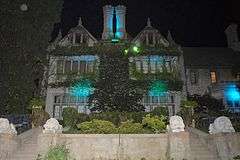 | |
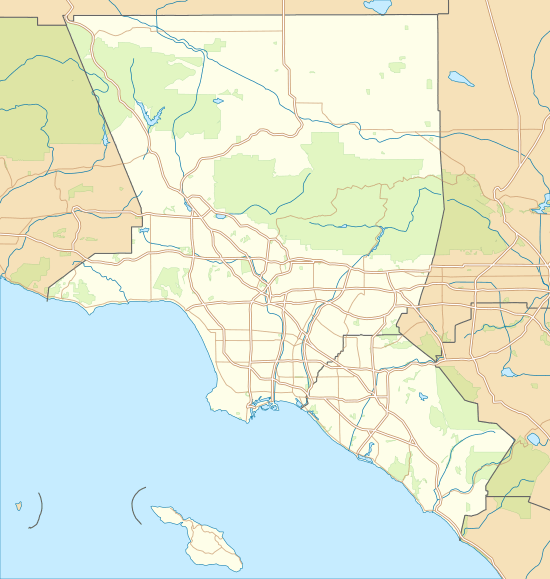 Playboy Mansion Location within the Los Angeles metropolitan area  Playboy Mansion Playboy Mansion (California)  Playboy Mansion Playboy Mansion (the United States) | |
| General information | |
| Type | House |
| Architectural style | Gothic Revival Tudor Revival |
| Location | 10236 Charing Cross Road, Los Angeles, California |
| Coordinates | 34°4′35.0″N 118°25′46.6″W |
| Construction started | 1927 |
| Owner | Daren Metropoulos[1] |
| Technical details | |
| Floor area | 21,987 sq ft (2,042.7 m2) |
| Design and construction | |
| Architect | Arthur R. Kelly |
| Other information | |
| Number of rooms | 29 |
History
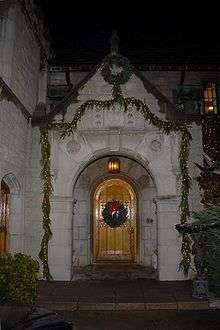
The 21,987-square-foot (2,042.7 m2) house is described as in the "Gothic-Tudor" style by Forbes magazine, and sits on 5.3 acres (2.1 ha). It was designed by Arthur R. Kelly in 1927 for Arthur Letts, Jr., son of the Broadway department store founder Arthur Letts and acquired by Playboy in 1971 for $1.1 million, from Louis D. Statham (1908–1983), an engineer, inventor and chess aficionado.[6] In early 2011, it was valued at $54 million.[7] It sits close to the northwestern corner of the Los Angeles Country Club, near University of California, Los Angeles, and the Bel-Air Country Club. $15 million has been invested in renovation and expansion.
The mansion has 29 rooms including a wine cellar (with a Prohibition-era secret door), a screening room with built-in pipe organ, a game room, three zoo / aviary buildings (and related pet cemetery), a tennis/basketball court, a waterfall and a swimming pool area (including a patio and barbecue area, a grotto, a basement gym with sauna below the bathhouse). Landscaping includes a large koi pond with artificial stream, a small citrus orchard and two well-established forests of tree ferns and redwoods. The west wing (originally servant's wing) houses the Editorial offices of Playboy. The main Aviary building is the original greenhouse, with four guestrooms adjoining. The Master suite occupies several rooms on the second and third floors, and is the most heavily renovated area of the Mansion proper, with an extensive carved-oak decor dating to the 1970s. Otherwise, the Mansion proper is maintained in its original Gothic-revival furnishings for the most part. The pipe organ was extensively restored in the last decade. There is also an outdoor kitchen to serve party events. These features and others have been shown on television.
The game room (game house) is a separate building on the north side. From the fountain in front of the main entrance, there are two sidewalks, running past a wishing-well. That on the right leads to the game house and runs past a duplicate Hollywood Star of Hefner. Its front entrance opens to a game room with a pool table in the center. This room has vintage and modern arcade games, pinball machines, player piano, jukebox, television, stereo, and couch. The game house has two wings. Left is a room with a soft cushioned floor, mirrors all around, television. There is a restroom with a shower. The right wing of the game house has a smaller restroom, and entrance to a bedroom. This bedroom is connected to another, which has an exit to the rear backyard of the game house. The game house has a backyard with lounge chairs, and gates on either side.
In 2010, Hefner's former girlfriend, Izabella St. James, wrote in her memoir, Bunny Tales, that the house was in need of renovation: "Everything in the Mansion felt old and stale, and Archie the house dog would regularly relieve himself on the hallway curtains, adding a powerful whiff of urine to the general scent of decay".[8] She also noted: "Each bedroom had mismatched, random pieces of furniture. It was as if someone had gone to a charity shop and bought the basics for each room", and that: "The mattresses on our beds were disgusting – old, worn and stained. The sheets were past their best, too."[9]
The mansion next door is a mirror image of the Playboy Mansion layout, only smaller, and was purchased by Hefner in 1996 as the home for his separated wife Kimberley Conrad and their children, Marston and Cooper. Hefner and Conrad married in 1989 and separated in 1998. In March 2009, Hefner and Conrad put the property up for sale for the asking price of $28 million.[10] In August 2009, the property was purchased by Daren Metropoulos for $18 million.[11]
In 2002, Hefner purchased a house across and down the street from the mansion for use by Playmates and other guests who would prefer to stay further from the busy activity of the Mansion proper. That residence was commonly referred to as the Bunny House. In April 2013, the Bunny House was listed for sale for $11 million.[12] In September 2017, it was sold to an unidentified buyer for $17.25 million.[13]
Sale of Playboy Mansion
In January 2016, the Playboy Mansion was listed for sale by Playboy Enterprises, Inc. for the asking price of $200 million, subject to the condition Hefner be allowed to continue to rent the mansion for life.[14] In August 2016, the Playboy Mansion was bought for $100 million by Daren Metropoulos, the co-owner of Hostess Brands and a principal in the investment firm C. Dean Metropoulos & Co.[15] Metropoulos intends to renovate and restore the mansion to its original form.[1]
In 2009, Metropoulos bought the mansion next door to the Playboy Mansion from Hefner and his ex-wife Kimberly Conrad, and ultimately wants to join the two properties. Both the Playboy Mansion and the mansion next door owned by Metropoulos were designed by American architect Arthur R. Kelly, and each estate has a common boundary with the Los Angeles Country Club.[16]
In May 2016, Eugena Washington was the last Playmate of the Year to be announced by Hefner at the Playboy Mansion.[17]
Permanent protection covenant
In March 2018, Daren Metropoulos, the owner of the Playboy Mansion, entered into an agreement with the City of Los Angeles which permanently protects the mansion from demolition.[18] The agreement between Metropoulos and the City of Los Angeles, referred to between the parties as a “permanent protection covenant,” is binding on all future owners. The agreement protects the estate from demolition, but still allows Metropoulos to make modernizations and substantial renovations and repairs to the mansion "following a long period of deferred maintenance" while under Playboy ownership.[19]
Under the permanent protection covenant, Metropoulos has further agreed to restore the house and facade to "its original grandeur." The compromise agreement reversed a move in November 2017 by Los Angeles City Councilmember Paul Koretz to seek landmark status for the mansion in the hope of protecting the architectural integrity of the estate for what he called "an excellent example of a Gothic-Tudor."[20] If designated a historic landmark, Metropoulos would have faced a lengthy process for permitting and review for the rehabilitation of the property. The permanent protection covenant avoided a potentially drawn out and contentious legal action between the City of Los Angeles and Metropoulos for the City of Los Angeles seeking the formal designation of the mansion as a historic landmark.[18][21]
Original Chicago mansion
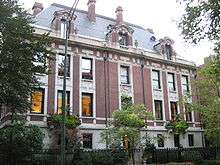
The original Playboy Mansion was a 70-room, 30,000 sq ft (2,800 m2)[22] classical brick and limestone residence in Chicago's Gold Coast district at 1340 North State Parkway which had been built in 1899 for Dr. George Swift Isham, a prominent surgeon whose social circle included Theodore Roosevelt and Robert Peary; it was acquired by Hefner in 1959.[23] The building was designed by architect James Gamble Rogers, best known for his work at Yale University and Columbia University.[24] The mansion's basement, Hefner's original "grotto", had a swimming pool with a glass wall and attached bar. In addition to a game room and bowling alley, the residence contained a two-floor dormitory for Bunnies employed at the Chicago Playboy Club and discrete apartments that were occupied by several employees, including longtime Hefner aide Bobbie Arnstein.
For a period in the 1970s, Hefner divided his time between Chicago and the Mansion West. The Chicago mansion boasted a brass plate on the door with the Latin inscription Si Non Oscillas, Noli Tintinnare ("If you don't swing, don't ring").
Although Playboy Enterprises was headquartered in Chicago until 2012, Hefner left the city permanently for Los Angeles in 1974 following the conviction and ensuing suicide of Bobbie Arnstein, the culmination of an "investigation of drug use in Hefner's mansion" by U.S. Attorney for the Northern District of Illinois (and future Governor of Illinois) James R. Thompson.[25] Derick Daniels (who served as president and chief operating officer of Playboy Enterprises from 1976 to 1982) resided in an apartment at the mansion during his tenure with the company. Eventually, the property was turned into a dormitory for the School of the Art Institute of Chicago, with Hefner formally deeding the building to the Art Institute in 1989. In 1993, the mansion was sold to developer Bruce Abrams and converted into four high-price luxury condos.[26] In 2011, one 7,874 sq ft (731.5 m2) condominium was placed for sale at an asking price of $6.7 million.[27]
Events and appearances
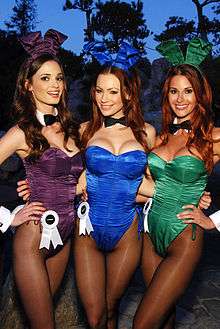
- The house can be seen in the 1966 film Madame X, before it was purchased by Playboy.
- The Playboy Mansion was used as a film location in Beverly Hills Cop II, with Hefner as himself in a cameo role.
- The mansion was a main setting in the 2008 film The House Bunny, and Hugh Hefner again portrayed himself.[28]
- The mansion's front gate appeared in the 2011 film Hop in which EB tries to request lodging in the mansion only for Hefner (in a voice-only appearance as himself, heard over the entry phone) to turn him away. Later, when the Pink Berets are searching for EB outside of the mansion, Hefner comes on the entry phone again and threatens to put a stop to what ever is going on outside. The Pink Berets respond by smashing the camera.
- The mansion is briefly mentioned in the last panel of the Big Nate comic's October 10, 2016 strip, in which Nate requests permission to interview Mr. Galvin for the school newspaper which Mr. Galvin denies as the last time Nate wrote about him, he Photoshopped Mr. Galvin's head on to a photo of Leonardo DiCaprio at the Playboy Mansion, causing readers to jump to the false conclusion that Mr. Galvin was a "philandering party animal."[29]
Financial
According to Playboy Enterprises' SEC filings, Hefner paid Playboy rent for "that portion of the Playboy Mansion used exclusively for him and his personal guests' residence as well as the per-unit value of non-business meals, beverages and other benefits received by him and his personal guests". This amount was $1.3 million in 2002, $1.4 million in 2003, and $1.3 million in 2004.
Playboy paid for the Mansion's operating expenses (including depreciation and taxes), which were $3.6 million in 2002, $2.3 million in 2003, and $3.0 million in 2004, net of rent received from Hefner.[30]
Charity events
The Playboy Mansion has hosted charity events, including Karma Foundation, the Celebrity Poker Tournament,[31] a fundraising party for the Marijuana Policy Project,[32] and an event to benefit research into autism.
2011 bacterial outbreak
In February 2011, 123 people complained of fever and respiratory illness after attending a DomainFest Global conference event held at the Playboy Mansion. Epidemiologists from the Los Angeles County Department of Public Health reported their findings at a Centers for Disease Control conference that the disease outbreak was traced to a hot tub in the mansion's famed grotto, where they found Legionella pneumophila, which causes Legionnaires' disease.[33][34]
See also
References
- Leitereg, Neal J. (August 27, 2016). "Daren Metropoulos takes ownership of Playboy Mansion, Hef included". Los Angeles Times. Archived from the original on September 29, 2018. Retrieved September 28, 2018.
- Boot, William (January 16, 2016). "The Playboy Mansion in the 1970s". The Daily Beast. Archived from the original on November 17, 2019. Retrieved February 20, 2019.
- Oswald, Anjelica (September 28, 2017). "Playboy Mansion photos: Celebrities who visited Hugh Hefner's home". Thisisinsider.com. Archived from the original on January 14, 2019. Retrieved February 20, 2019.
- Stow, Katie (September 29, 2017). "Look Back at Hugh Hefner's Opulent Life With These Vintage Photographs". Archived from the original on November 3, 2018. Retrieved November 2, 2018.
- Larsen, Peter (September 28, 2017). "Hugh Hefner's Southern California legacy includes the Playboy Mansion parties, the iconic Hollywood sign, and all that jazz". New York Daily News. Archived from the original on April 15, 2019. Retrieved February 20, 2019.
- Playboy Enterprises Annual Report Archived March 4, 2012, at the Wayback Machine. Accessed July 9, 2014.
- Church, Steven (February 11, 2011). "Playboy Mansion Worth $54 Million, 45 Times What Hefner Claims, Suit Says". Bloomberg.com. Archived from the original on December 17, 2014. Retrieved December 22, 2014.
- Article Archived October 9, 2011, at the Wayback Machine at Shelterpop.com
- "Celebrity Homes: Inside the Crumbling, Sorry State of the Playboy Mansion". October 21, 2015. Archived from the original on August 17, 2016. Retrieved August 19, 2016.
- Lewis, Christina S.N. (March 13, 2009). "Hefners List L.A. Mansion for $US28 Million". Wall Street Journal. Archived from the original on December 17, 2014. Retrieved March 13, 2009.
- "Sold to a younger playboy". Los Angeles Times. August 8, 2009. Archived from the original on April 6, 2020. Retrieved April 7, 2020.
- Gould, Jennifer (September 16, 2017). "Playboy Bunny Ranch sold for $17.25M". New York Post. Archived from the original on June 17, 2018. Retrieved February 20, 2019.
- Frank, Robert, "Playboy Mansion on sale for $200 million – Hef included" Archived September 10, 2017, at the Wayback Machine, cnbc.com, January 11, 2016.
- Isadore, Chris, "Playboy Mansion sold for $100 million" Archived August 18, 2016, at the Wayback Machine, CNNMoney, August 17, 2016.
- "Daren Metropoulos takes ownership of Playboy Mansion, Hef included". Archived from the original on November 15, 2016. Retrieved January 15, 2017.
- "Hugh Hefner Crippling Back Infection Started Decline in Health". TMZ. September 29, 2017. Archived from the original on November 12, 2017. Retrieved November 11, 2017.
- "Deal Reached to Permanently Protect Playboy Mansion". March 6, 2018. Archived from the original on March 21, 2018. Retrieved March 20, 2018.
- Kohli, Sonali (March 6, 2018). "L.A.'s famous Playboy Mansion is spared the wrecking ball". Los Angeles Times. Archived from the original on March 21, 2018. Retrieved March 20, 2018.
- "The Playboy Mansion Won't be Demolished After All". Archived from the original on March 24, 2018. Retrieved March 23, 2018.
- Pimentel, Joseph (March 7, 2018). "New Agreement, Not Historic Landmark Status, Will Keep Playboy Mansion Intact". Archived from the original on March 21, 2018. Retrieved March 20, 2018.
- Gause, Jo Allen; Hoch, Bruce M.; MacOmber, John D.; Rose, Jonathan F. P.; Institute, Urban Land (1996). New Uses for Obsolete Buildings. ISBN 978-0-87420-802-3.
- "Playboy Mansion Condo Features Original 1899 Ballroom". Archived from the original on November 27, 2016. Retrieved November 26, 2016.
- "Chicago – Architecture & Cityscape: The original Playboy Mansion". March 12, 2009. Archived from the original on July 8, 2011. Retrieved September 17, 2009.
- "High in America – Chapter 8". Archived from the original on April 23, 2017. Retrieved November 26, 2016.
- "Original Playboy Mansion". Lonely Planet. Archived from the original on December 5, 2013. Retrieved December 12, 2013.
- Boyer, Mark (July 20, 2011). "First Look Inside that $6.7M Condo in the Playboy Mansion". Curbed Chicago. Archived from the original on June 26, 2012. Retrieved December 12, 2013.
- "Bunny beautiful". Archived from the original on April 2, 2015. Retrieved March 13, 2015.
- "Big Nate". Archived from the original on January 30, 2019. Retrieved January 29, 2019.
- "Morningstar Document Research: SEC filings". ccbn.tenkwizard.com. Archived from the original on July 8, 2012. Retrieved September 28, 2018.
- "Celebrity Poker Tournament". charitypokertournament.net. Archived from the original on May 2, 2008. Retrieved May 3, 2008.
- "Marijuana Policy Project Party". mpp.org. Archived from the original on June 10, 2008. Retrieved June 11, 2008.
- "Playboy Mansion illness traced to hot tub bacteria". The Associated Press. Associated Press. April 15, 2011. Retrieved April 16, 2011.
- Lin, Rong-Gong, II (April 22, 2011). "Playboy's mystery outbreak". Los Angeles Times. Archived from the original on April 29, 2011. Retrieved April 23, 2011.
External links
| Wikimedia Commons has media related to Playboy Mansion. |